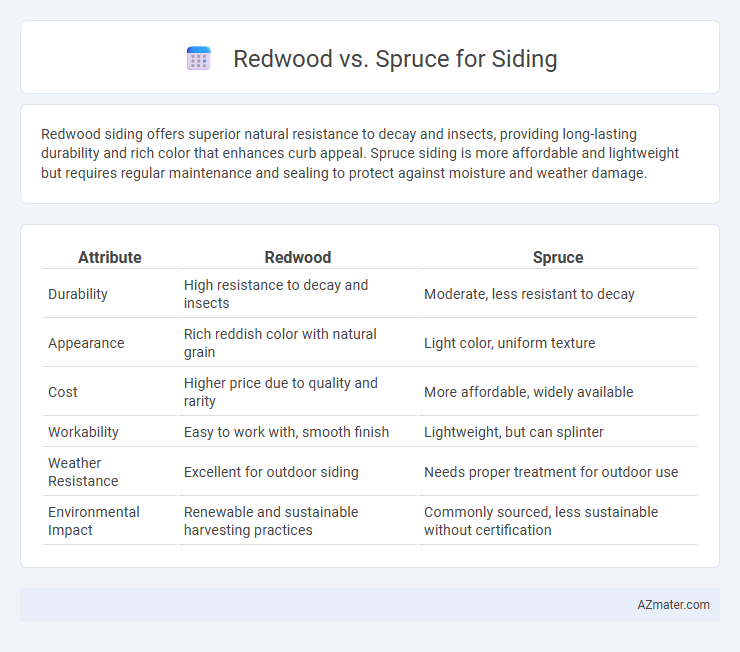Redwood siding offers superior natural resistance to decay and insects, providing long-lasting durability and rich color that enhances curb appeal. Spruce siding is more affordable and lightweight but requires regular maintenance and sealing to protect against moisture and weather damage.
Table of Comparison
| Attribute | Redwood | Spruce |
|---|---|---|
| Durability | High resistance to decay and insects | Moderate, less resistant to decay |
| Appearance | Rich reddish color with natural grain | Light color, uniform texture |
| Cost | Higher price due to quality and rarity | More affordable, widely available |
| Workability | Easy to work with, smooth finish | Lightweight, but can splinter |
| Weather Resistance | Excellent for outdoor siding | Needs proper treatment for outdoor use |
| Environmental Impact | Renewable and sustainable harvesting practices | Commonly sourced, less sustainable without certification |
Introduction: Redwood vs Spruce Siding
Redwood siding offers exceptional durability, natural resistance to decay, and a rich, warm appearance, making it a premium choice for exterior cladding. Spruce siding is valued for its affordability, lightweight properties, and ease of installation, though it requires regular maintenance to protect against weathering. Both options provide unique aesthetic and performance characteristics tailored to different budgets and environmental conditions.
Wood Characteristics and Appearance
Redwood siding features rich reddish-brown tones with a fine, straight grain that offers natural durability and resistance to decay and insects, making it ideal for exterior cladding. Spruce siding displays lighter, pale yellow to cream hues with a more uniform texture and moderate hardness, providing a cost-effective and workable option but requires protective treatments for enhanced weather resistance. Both woods offer distinctive aesthetics, with redwood prized for its vibrant color and natural resilience, while spruce is favored for its affordability and ease of finishing.
Durability and Longevity Comparison
Redwood siding offers superior natural resistance to rot, decay, and insect damage due to its high tannin content, resulting in greater durability compared to spruce. Spruce siding, while more affordable, requires regular maintenance and protective treatments to achieve similar longevity. Overall, redwood typically outlasts spruce by several years under comparable environmental conditions, making it a more sustainable choice for long-term siding performance.
Resistance to Decay and Insects
Redwood offers superior resistance to decay and insects compared to spruce, thanks to its natural oils and dense grain structure that act as protective barriers. Spruce, being a softer wood, is more susceptible to moisture retention and insect infestation, which can lead to faster deterioration. For long-lasting siding, redwood's resistance properties significantly reduce maintenance and enhance durability in various environmental conditions.
Maintenance Requirements
Redwood siding offers superior resistance to decay and insects, requiring minimal maintenance such as occasional sealing or staining to preserve its natural color and durability. Spruce siding, while more affordable, demands regular painting or staining every 2-3 years to protect against moisture damage and prevent rot. Homeowners seeking low-maintenance options often prefer redwood for its natural oils and stability, reducing long-term upkeep costs compared to spruce.
Climate Suitability
Redwood siding excels in wet, humid climates due to its natural resistance to moisture, decay, and insect damage, making it ideal for coastal and rainy regions. Spruce, being less resistant to moisture, is better suited for dry or moderate climates where excessive humidity and precipitation are minimal. Choosing Redwood over Spruce for siding in climates with high rainfall or humidity enhances durability and reduces maintenance costs.
Environmental Sustainability
Redwood siding is known for its natural resistance to decay and insect damage, allowing for longer lifespan and reducing the need for chemical treatments, which benefits environmental sustainability. Spruce, often harvested from fast-growing forests, offers a renewable and more affordable option but requires proper maintenance and treatments to enhance durability and longevity. Choosing sustainably sourced Redwood certified by the Forest Stewardship Council (FSC) or FSC-certified Spruce ensures responsible forestry management and supports ecosystem preservation.
Cost and Availability
Redwood siding tends to cost significantly more than spruce due to its natural resistance to decay and its rich appearance, making it a premium choice for exterior cladding. Spruce is more readily available and generally less expensive, often favored for budget-conscious projects but may require additional treatment for durability. Availability of redwood can be limited depending on the region, whereas spruce is widely stocked across North American lumber suppliers, influencing both price and purchasing convenience.
Installation Considerations
Redwood siding offers exceptional ease of installation due to its stability and resistance to warping, making it ideal for precise fitting and long-term durability. Spruce siding requires careful handling and treatment to prevent moisture damage and warping during installation, often necessitating additional protective coatings and fastening techniques. Proper ventilation and moisture barriers are critical for both woods to ensure longevity and prevent structural issues in siding applications.
Final Verdict: Choosing the Right Wood for Your Siding
Redwood offers superior natural resistance to decay and insect damage, making it ideal for siding in humid or coastal climates, while spruce provides a more affordable option with a lighter color and good structural strength but requires regular maintenance and treatment. The final choice depends on your budget, environmental conditions, and desired aesthetic; redwood is optimal for long-term durability and rich color retention, whereas spruce suits projects prioritizing cost-efficiency and ease of painting or staining. Selecting the right wood ensures your siding maintains its structural integrity and curb appeal for years to come.

Infographic: Redwood vs Spruce for Siding
 azmater.com
azmater.com